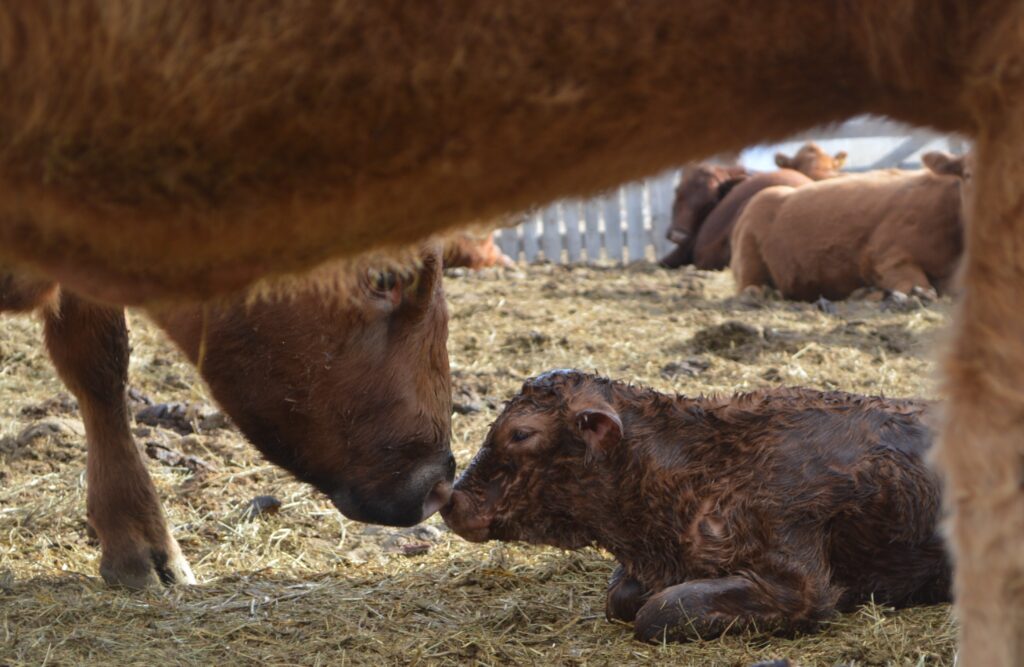Top findings about adoption of beneficial practices on Canadian cow-calf operations

Sometimes it can be hard to know where you’re going if you don’t look at where you’ve been. For decades, research and extension organizations have promoted many practices to beef cattle operators with the goals of improving production, product safety, and ultimately profitability. Recently, the Beef Cattle Research Council (BCRC) and Canfax Research Services created a comprehensive report outlining the adoption of recommended beef management practices over time and across Canada.
The analysis used a broad lens to examine all cow-calf practices from feeding methods to manure management, calving cows to retaining heifers, pasture management to feed testing, and everything in between. Recent data from regional cow-calf surveys and research studies were compared to foundational producer survey and Statistics Canada information dating as far back as thirty-five years.
The first of its kind, this analysis:
- Consolidated benchmarks for parameters such as conception rates, weaning weights, death loss, and calving season length;
- Compared current practices and highlighted long-term trends across Canada where possible;
- Identified gaps in adoption and potential extension opportunities;
- Recognized and addressed barriers for adoption.
New innovations, including broad-scale technologies such as smartphones and internet, have changed the way producers can manage their herds and the way they learn new information. On the other hand, certain practices, such as calving, weaning, and breeding, are standard to any functioning cow-calf operation, but these have shifted over time too. Weaning weights have generally increased from 558 lb (Alberta, 1988) up to over 600 lb as reported in the latest surveys across Canada. While that is good news, calf death loss has increased across most regions of Canada over time also, prompting a need to address preventing mortality early in the calf’s life.
Key findings include:
- Painful procedures have been a necessary part of the beef business forever, however producers today have new tools to manage pain and they are using them. Across Canada, nearly half of producers are using pain mitigation some or all of the time (including NSAIDs or local anesthetics).
- Reducing stress at weaning is key to reducing losses along the value chain. Traditional abrupt weaning has gone down from 70% in 2014 to less than 50% in 2017 in Western Canada, and low-stress techniques like two-stage and fence-line separation has increased from 28% in 2014 up to 45% in 2017, showing a positive shift in a short term.
- Vaccination rates vary greatly however the numbers point to a need for improvement. One third of Ontario producers do not vaccinate their cows for BVD and far fewer vaccinate for other reproductive diseases, leaving herds vulnerable. In western Canada, more than a quarter of producers do not vaccinate cows for reproductive diseases. Only one third of Atlantic and Ontario producers vaccinate their cowherd for scours, in spite of scours being reported as one of the most common causes of calf mortality in these regions. Vaccination is a proven tool for disease prevention and Canadian beef producers are not using it to its potential.
- Pregnancy checking is on the rise across Canada. Two-thirds of producers across Western Canada and Ontario, and half of the producers in Atlantic Canada preg-check and capitalize on marketing open cows at the optimum time.
- Open cows have a substantial negative impact on herd profitability. The information available indicates that open rates are increasing in western Canada (from 6.5% in 1988-91 up to 7.3% in 2017) and decreasing in Ontario (from 13% in 1983 down to 10.9% in 2017).
- Land tenure is changing and potentially impacting practices like forage rejuvenation and rotational grazing. Benchmark data from Alberta showed that in 1986-89, only 37% of beef producers rented land compared to 2017 where 62% of western Canadian producers rented land. The same survey also reported producers are less likely to incorporate rotational grazing on rented or leased land, compared to land they own themselves.
- Winter feeding practices have shifted away from feeding in confinement toward extensive feeding (like swath or bale grazing, or using stockpiled forages). While regional differences affect uptake of extensive feeding, Statistics Canada reported that in 2011, 39% of beef producers across Canada fed extensively, which has increased from 28% in 2006. Feed comprises a large proportion of the cost of production on most cow-calf operations, and producers are taking steps to reduce that.
What motivates producers to change? What might stop them?

Whether or not beef farmers decide to adopt certain practices, technologies or innovations is complicated. Understanding perceived and actual barriers is vital in order to encourage producers to take the next steps toward profitability. Money is commonly cited as a barrier to adoption. Perhaps the desire to change may be there however producers feel limited by market prices or unexpected circumstances, such as drought, fire or flood. On the other hand, survey responses showed that decisions are motivated by more than finances. Producers are nearly as likely to adopt a new practice that will improve environmental sustainability, regardless of potential economic benefits. Also interesting, data shows that when producers adopt some ideas, such as winter grazing, it often leads to incorporating other practices, such as later calving. Building off of current practices might be the nudge some producers need.
It is important to note that not every production practice is applicable on all farms. A producer with a small herd size may not invest in GPS technology to seed their crops because of a lack of economies of scale. Regional variability also plays a role. Canada is vast, and a particular production practice in British Columbia may not be relevant to a producer in the Maritimes.
Across the country, there has been a shift toward fewer farms with larger herd sizes, and more than 50% of beef farm operators are over the age of 55. There will be an inevitable generational shift toward younger operators in the future. Producers who are nearing retirement may be less willing to adopt practices that require an investment of time or capital. On the flip side, their younger counterparts demonstrate a higher rate of technology adoption when labour and money allow. This presents a great opportunity to leverage interest in innovation among a new generation of producers.
When asked to identify why they do not adopt a particular recommended practice, most producers suggest they aren’t experiencing a problem so they don’t feel it’s a priority to address. This mindset can be risky. Often, by the time a production problem presents itself, it may be too late to fix and losses have already occurred. Beef farmers stand to make substantial gains and improvements in their herds by considering new practices rather than reacting after a wreck takes place.
Hindsight can be very useful and evidence gained from producer surveys is a valuable yardstick for the entire Canadian beef sector. The ability to measure the uptake of new and old practices as research and innovation shifts will help organizations develop tools and other extension strategies and create effective programming that can be tailored to a region. This will have a positive impact on the farm level, and right through the entire value chain.
You can read the entire report here.